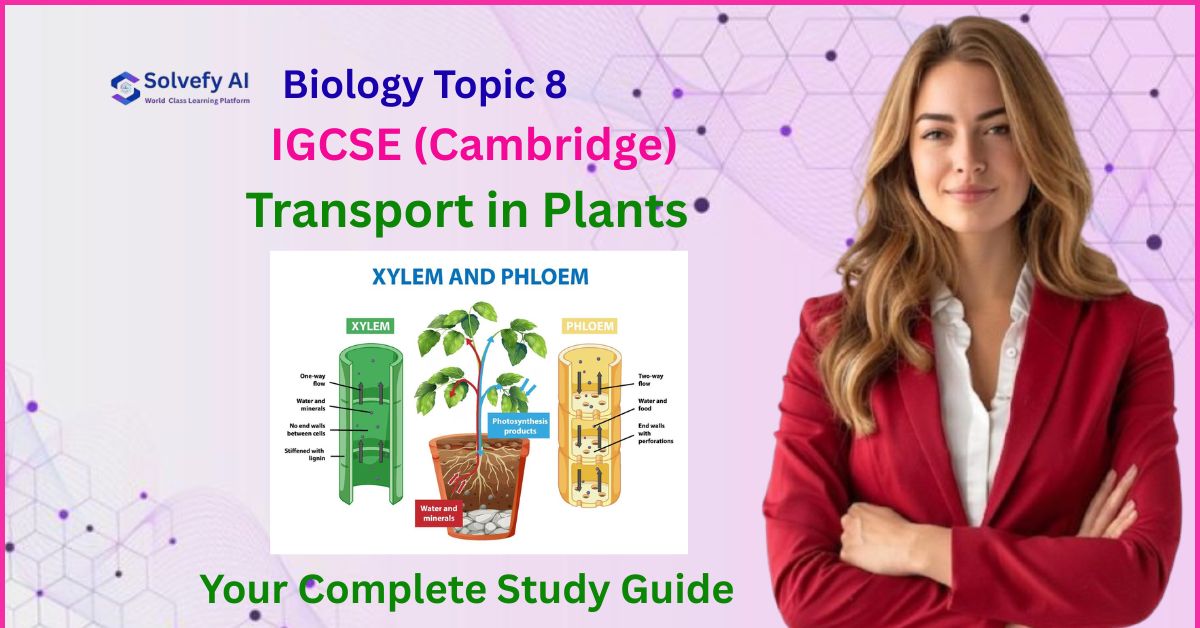The Hidden Highways Inside Plants
Have you ever wondered how a tall tree gets water from its roots all the way up to leaves that might be 100 meters high? Or how the sugar produced in leaves during photosynthesis reaches the roots buried deep underground?
Think about it-plants don’t have hearts to pump fluids like we do. They can’t move around to find food or water. Yet, they manage to transport materials efficiently throughout their entire structure, sometimes over enormous distances! This incredible feat is what we’re going to explore in Topic 8: Transport in Plants.
Understanding plant transport isn’t just academic-it’s the reason we have food on our tables, oxygen to breathe, and forests that regulate our climate. Whether you’re biting into an apple or admiring a flower, you’re witnessing the end result of an amazing transport system that’s been perfected over millions of years of evolution.
Let’s dive into this fascinating topic and discover how plants have solved the challenge of moving water, minerals, and food without a single moving part!
Why Do Plants Need Transport Systems?
Before we get into the “how,” let’s understand the “why.”
Plants need transport systems for several crucial reasons:
1. Size and Complexity
- Multicellular plants can be huge (think redwood trees!)
- The distance between roots and leaves can be many meters
- Simple diffusion is too slow for long distances
- Different parts have specialized functions and need specific materials
2. Localized Absorption and Production
- Water and minerals are absorbed only by roots
- Photosynthesis happens mainly in leaves
- Both roots and leaves need products from each other
- Growth occurs in specific regions that need resources
3. Meeting Metabolic Demands
- Every living cell needs water for chemical reactions
- Cells require minerals for various functions
- Energy (in the form of sugars) must reach all parts
- Waste products need removal
The Big Picture: Plants need TWO separate transport systems—one for water and minerals (moving upward) and another for sugars and amino acids (moving in multiple directions). These are like the “arteries and veins” of the plant world!
The Structure of Plant Transport Systems
Plants have evolved two specialized tissues for transport, each with its own unique structure and function. Let’s explore them in detail.
Xylem: The Water Superhighway
What is Xylem?
Xylem is the tissue responsible for transporting water and dissolved mineral ions from the roots to all other parts of the plant, particularly the leaves.
Structure of Xylem Vessels:
Xylem vessels are made of dead cells-yes, you read that right! These cells die and lose their end walls, forming continuous hollow tubes. Here’s what makes them special:
- Hollow tubes: Long, continuous pipes formed from dead cells stacked end-to-end
- Lignified walls: Cell walls are strengthened with lignin (a tough, waterproof substance)
- No cytoplasm or nucleus: Completely hollow inside for maximum water flow
- Pits in walls: Small gaps that allow lateral water movement between vessels
- Thick, strong walls: Prevent collapse under negative pressure
Why Dead Cells?
This might seem strange, but it’s brilliant design! Dead cells:
- Create an unobstructed pathway for water flow
- Don’t use energy or require maintenance
- Can withstand enormous pressure without bursting
- Provide structural support to the plant
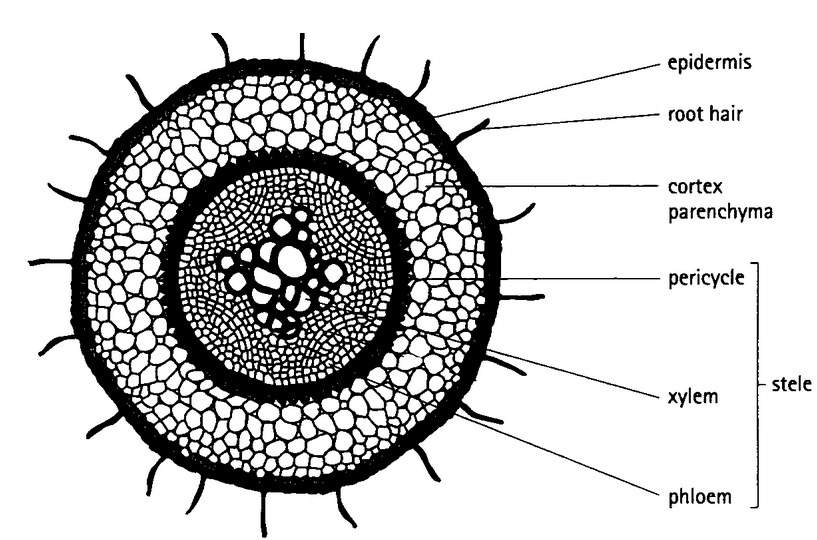
Supporting Cells in Xylem:
- Tracheids: Tapered cells with pits, found in all vascular plants
- Xylem parenchyma: Living cells that store food and help in lateral transport
- Xylem fibres: Provide additional mechanical support
Phloem: The Food Distribution Network
What is Phloem?
Phloem is the living tissue that transports organic compounds (mainly sugars like sucrose) and amino acids from leaves (where they’re made) to all other parts of the plant where they’re needed or stored.
Structure of Phloem:
Unlike xylem, phloem is made of LIVING cells. The main components are:
1. Sieve Tube Elements:
- Living cells arranged end-to-end forming sieve tubes
- End walls have small pores called sieve plates
- Very little cytoplasm (more space for transport)
- No nucleus in mature cells (still alive, though!)
- Thin cellulose walls (not lignified)
2. Companion Cells:
- Living cells with dense cytoplasm and large nucleus
- Located next to each sieve tube element
- Connected by plasmodesmata (microscopic channels)
- Control the activities of sieve tube elements
- Provide energy (ATP) for active transport
Why are companion cells essential?
Since sieve tube elements have no nucleus, they can’t control their own activities. Companion cells act like “life support systems,” keeping the sieve tubes functional!
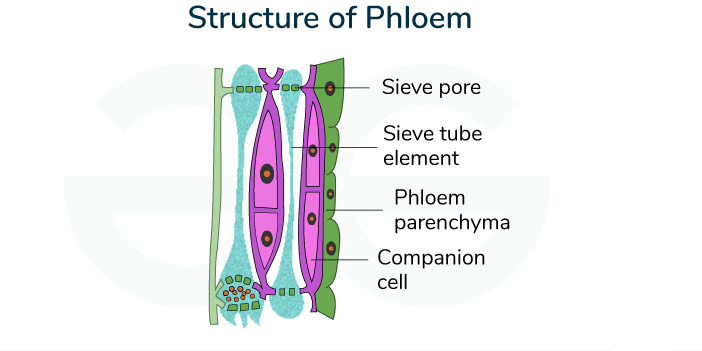
Comparing Xylem and Phloem
Let’s make this crystal clear with a comparison:
Comparison of Xylem and Phloem
| Feature | Xylem | Phloem |
|---|---|---|
| Cell type | Dead cells (vessels and tracheids) | Living cells (sieve tubes & companion cells) |
| Cell walls | Thick, lignified | Thin, cellulose |
| Cell contents | Hollow (no cytoplasm) | Some cytoplasm, no nucleus in sieve tubes |
| End walls | Completely broken down | Sieve plates with pores |
| Direction of flow | Upward (roots → leaves) | Multi-directional (source → sink) |
| Materials transported | Water and mineral ions | Sugars (sucrose) and amino acids |
| Transport mechanism | Passive (transpiration pull) | Active (requires energy) |
| Support function | Yes (lignin provides strength) | No |
Water Uptake by Roots
The journey of water through a plant begins underground. Let’s follow a water molecule from the soil into the plant!
Root Structure for Water Absorption
Root Hairs: Nature’s Absorption Specialists
Root hairs are tiny extensions of root epidermal cells that dramatically increase the surface area for water absorption.
Key Features:
- Microscopic projections from root surface cells
- Large surface area (one plant can have billions!)
- Thin cell walls for easy water penetration
- Grow into spaces between soil particles
- Short-lived (few weeks) but constantly replaced
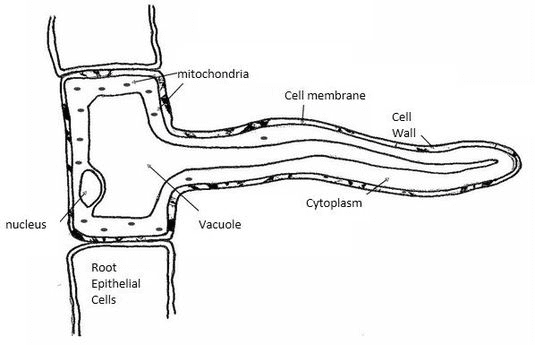
How Water Enters Root Cells: Osmosis in Action
Step-by-Step Process:
1. Concentration Gradient Setup:
- Soil water has low solute concentration (dilute)
- Root hair cell sap has high solute concentration (lots of dissolved minerals and sugars)
- This creates a water potential gradient
2. Osmosis Occurs:
- Water moves from high water potential (soil) to low water potential (root hair cell)
- Movement occurs across the partially permeable cell membrane
- No energy required-it’s passive!
3. Chain Reaction:
- Water entering the root hair cell dilutes its contents
- This cell now has higher water potential than the next cell inward
- Osmosis continues from cell to cell across the root cortex
- Eventually, water reaches the xylem vessels
Important Definition Box:
Osmosis: The net movement of water molecules from a region of higher water potential (dilute solution) to a region of lower water potential (concentrated solution) through a partially permeable membrane.
Pathways Across the Root
Water can take three routes across the root:
1. Apoplast Pathway (through cell walls)
- Water moves through the spaces in and between cell walls
- Doesn’t enter cells until it reaches the endodermis
- Faster but can’t pass the Casparian strip
2. Symplast Pathway (through cytoplasm)
- Water moves through the living cytoplasm of cells
- Travels via plasmodesmata (connections between cells)
- Slower but more controlled
3. Vacuolar Pathway (through vacuoles)
- Water passes through cell vacuoles
- Similar to symplast but includes vacuole space
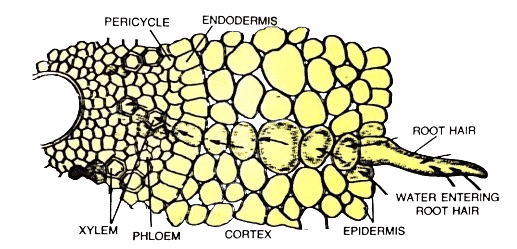
Transpiration: The Engine of Water Movement
Here comes one of the most fascinating processes in biology-how plants move water upward without any pump!
What is Transpiration?
Definition:
Transpiration is the loss of water vapour from the leaves and stems of plants through stomata (small pores).
Think of transpiration as “plant sweating”- but unlike sweating in animals, transpiration isn’t primarily for cooling. It’s a necessary consequence of gas exchange that plants have turned into an advantage!
The Structure of a Leaf for Gas Exchange
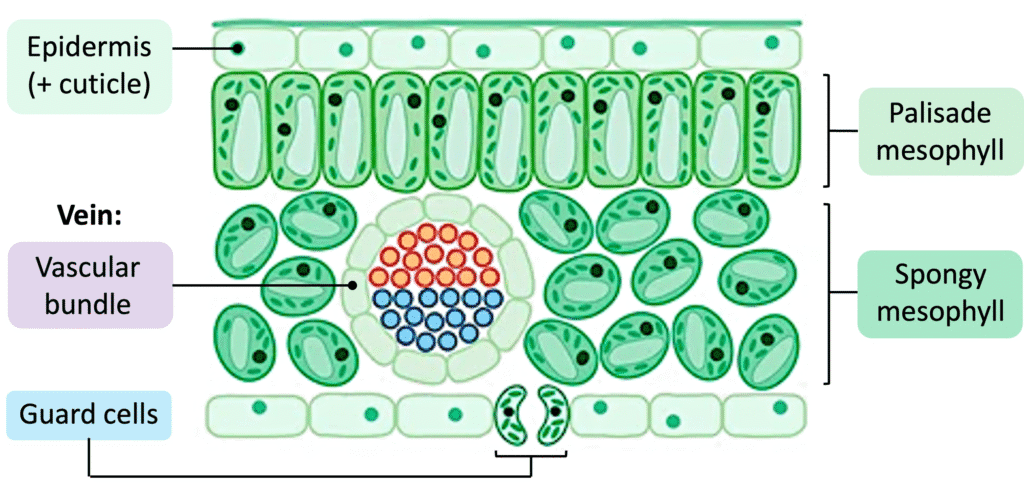
Key Leaf Structures:
1. Stomata (singular: stoma)
- Small pores on leaf surface (mainly on lower epidermis)
- Each pore is surrounded by two guard cells
- Guard cells can change shape to open/close the stoma
- Allow CO₂ in for photosynthesis
- Allow O₂ and water vapour out
2. Guard Cells
- Kidney-shaped cells surrounding each stoma
- Have chloroplasts (unlike other epidermal cells)
- Can change shape through osmosis
- Thicker inner walls, thinner outer walls
- Control stomatal opening and closing
How Stomata Open and Close:
Stomata OPEN (daytime):
- Guard cells photosynthesize and produce sugars
- Sugars lower water potential inside guard cells
- Water enters guard cells by osmosis
- Guard cells become turgid (swollen)
- Due to uneven wall thickness, cells bend outward
- Stoma opens
Stomata CLOSE (nighttime or water stress):
- Guard cells stop photosynthesizing (no light)
- Sugars are converted to starch or moved out
- Water potential increases in guard cells
- Water leaves guard cells by osmosis
- Guard cells become flaccid (limp)
- Stoma closes
The Transpiration Stream: How Water Moves Up
Now for the amazing part-how water can rise 100+ meters in tall trees!
The Mechanism (Four Connected Processes):
1. Evaporation from Mesophyll Cells
- Water evaporates from the wet cell walls of mesophyll cells
- Water vapour diffuses into air spaces in the leaf
- This creates a “pull” on the water in the cells
2. Diffusion Out Through Stomata
- Water vapour concentration is higher inside the leaf than outside
- Water vapour diffuses out through open stomata (down concentration gradient)
- This continues the “pull” on water
3. Cohesion and Tension in Xylem
- Water molecules stick together (cohesion) due to hydrogen bonds
- As water evaporates from leaves, it pulls on the continuous column of water in xylem
- This creates tension (negative pressure) in the xylem
- Water is “sucked up” rather than pushed up!
4. Water Uptake from Roots
- The pull on water extends all the way down to the roots
- More water is drawn into root hair cells by osmosis
- The cycle continues!
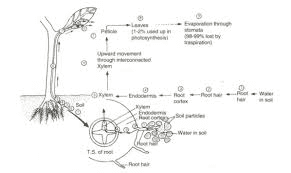
The Cohesion-Tension Theory Explained:
This is THE theory you need to know for exams!
- Cohesion: Water molecules stick together through hydrogen bonding
- Adhesion: Water molecules also stick to the xylem walls
- Tension: The “pull” created by evaporation from leaves
- Result: An unbroken column of water is pulled upward from roots to leaves
Why doesn’t the water column break?
The hydrogen bonds between water molecules are strong enough to withstand the tension. It’s like pulling a rope-if the rope is strong and continuous, you can pull items up very high!
Factors Affecting Transpiration Rate
Understanding what speeds up or slows down transpiration is crucial for exam success!
1. Light Intensity
- ↑ Light = ↑ Transpiration
- More light → stomata open wider
- More light → higher temperature on leaf surface
- More light → more photosynthesis (needs CO₂)
2. Temperature
- ↑ Temperature = ↑ Transpiration
- Water molecules have more kinetic energy
- Faster evaporation and diffusion
- However, extreme heat can cause stomata to close to prevent water loss!
3. Humidity
- ↑ Humidity = ↓ Transpiration
- Less difference in water vapour concentration between inside and outside leaf
- Slower diffusion gradient
- Humid air = air already saturated with water vapour
4. Air Movement (Wind)
- ↑ Wind = ↑ Transpiration
- Wind removes water vapour from around stomata
- Maintains steep concentration gradient
- However, strong wind can cause stomata to close
5. Surface Area of Leaves
- ↑ Surface Area = ↑ Transpiration
- More stomata available for water vapour loss
- Larger evaporating surface
Memory Tip: Remember “LT HAM” – Light, Temperature, Humidity, Air movement, (leaf) Magnitude!
Summary of Factors Affecting Transpiration
| Factor | Change | Effect on Transpiration | Why? |
|---|---|---|---|
| Light intensity | Increases | Increases | Stomata open wider |
| Temperature | Increases | Increases | Faster evaporation |
| Humidity | Increases | Decreases | Smaller concentration gradient |
| Wind speed | Increases | Increases | Removes water vapour from leaf surface |
| Leaf surface area | Increases | Increases | More stomata for evaporation |
Translocation: Moving the Food Around
While xylem transport is passive, phloem transport (called translocation) requires energy. Let’s explore this active process!
What is Translocation?
Definition:
Translocation is the movement of dissolved sugars (mainly sucrose) and amino acids from the leaves (where they are made) to other parts of the plant through the phloem sieve tubes.
Unlike water in xylem (which only goes up), substances in phloem can move:
- Downward: From leaves to roots
- Upward: From storage organs to growing tips
- Sideways: From leaves to fruits
The key concept is source to sink:
- Source: Where sugars are produced or released (photosynthesizing leaves, storage organs)
- Sink: Where sugars are used or stored (roots, fruits, seeds, growing tips)
The Mechanism of Translocation
This process is more complex than transpiration and requires energy (ATP)!
Step-by-Step Process:
1. Loading at the Source (e.g., leaf)
- Sugars are produced in leaf mesophyll cells during photosynthesis
- Sugars are actively transported into companion cells (requires ATP)
- Sugars move from companion cells into sieve tube elements via plasmodesmata
- This increases solute concentration in sieve tubes
2. Water Follows by Osmosis
- High sugar concentration in sieve tubes lowers water potential
- Water enters sieve tubes from nearby xylem by osmosis
- This creates high hydrostatic pressure (turgor pressure) at the source
3. Mass Flow Along Pressure Gradient
- High pressure at source pushes the solution along the sieve tubes
- Solution flows from high pressure to low pressure areas
- This is called mass flow
4. Unloading at the Sink (e.g., root)
- Sugars are actively transported out of sieve tubes (requires ATP)
- Sugars are used for respiration or converted to starch for storage
- This decreases solute concentration in sieve tubes
5. Water Exits
- Lower sugar concentration increases water potential in sieve tubes
- Water leaves sieve tubes by osmosis back into xylem
- This creates low hydrostatic pressure at the sink
- The pressure difference keeps the flow going
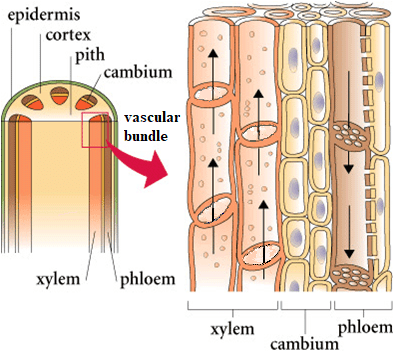
Key Point: Unlike transpiration (passive), translocation is ACTIVE-it requires ATP for loading and unloading sugars. The flow itself is passive (along a pressure gradient), but maintaining that gradient needs energy!
Evidence for Mass Flow Theory
How do scientists know this is how it works?
- Ringing experiments: Removing bark (containing phloem) causes sugars to accumulate above the ring
- Radioactive tracers: Radioactive carbon (¹⁴C) from photosynthesis can be tracked moving through phloem
- Aphid experiments: Aphids feed on phloem sap; when removed, sap continues flowing out under pressure
- Analysis of sap: Phloem sap contains high concentrations of sucrose
Adaptations of Plants to Reduce Water Loss
Plants face a dilemma: they need to open stomata for gas exchange (photosynthesis), but this causes water loss. Different plants have evolved fascinating adaptations!
Xerophytes: Desert Survival Specialists
Xerophytes are plants adapted to survive in dry conditions. Here are their clever strategies:
1. Reduced Leaf Surface Area
- Small leaves or needles (cacti, pine trees)
- Some leaves reduced to spines
- Less surface area = less evaporation
2. Thick Waxy Cuticle
- Extra-thick waterproof coating on leaves
- Reduces evaporation from leaf surface
- Gives leaves a shiny appearance
3. Sunken Stomata
- Stomata located in pits or grooves
- Creates a humid microenvironment
- Reduces water vapour diffusion gradient
4. Leaf Rolling
- Leaves roll up in dry conditions
- Traps humid air inside
- Reduces exposed surface area
5. Hairs on Leaf Surface
- Dense hair covering (trichomes)
- Traps moisture near stomata
- Reduces air movement
6. Stomata on Lower Surface Only
- Avoids direct sunlight exposure
- Lower temperatures on underside
- Reduces evaporation rate
7. Water Storage Tissues
- Thick, succulent stems or leaves
- Store water for dry periods
- Cacti can store hundreds of litres!
8. Reduced Number of Stomata
- Fewer stomata per unit area
- Less surface for water loss
- Still enough for minimal gas exchange
9. CAM Photosynthesis
- Stomata open at night (cooler, more humid)
- CO₂ stored as malic acid
- Stomata closed during hot day
- Uses stored CO₂ for photosynthesis
[INSERT DIAGRAM: Cross-section of a xerophytic leaf showing thick cuticle, sunken stomata in pits with hairs, reduced air spaces, and water storage tissue
Examples of Xerophytes:
- Cacti (thick stems, spines instead of leaves)
- Marram grass (rolled leaves, sunken stomata)
- Aloe vera (succulent leaves, water storage)
- Oleander (sunken stomata, thick cuticle)
Practical Applications and Real-Life Connections
Understanding plant transport isn’t just academic-it has real-world implications!
Agriculture and Crop Management
1. Irrigation Timing
- Water plants early morning or evening
- Less evaporation when it’s cooler
- Stomata more receptive to water uptake
2. Greenhouse Design
- Control humidity to reduce water stress
- Manage temperature to optimize transpiration
- Balance between growth and water conservation
3. Pesticide and Fertilizer Application
- Systemic pesticides travel through xylem
- Applied to soil, taken up by roots
- Distributed throughout plant
4. Crop Selection
- Choose appropriate plants for climate
- Xerophytes for dry regions
- Hydrophytes for wet areas
Environmental Science
1. Climate Change Impact
- Rising temperatures increase transpiration
- Plants may face water stress
- Affects ecosystem distribution
2. Water Cycle
- Plants return massive amounts of water to atmosphere
- Forests act as “water pumps”
- Deforestation affects regional rainfall
3. Carbon Sequestration
- Translocation moves carbon from air to roots
- Long-term carbon storage in wood
- Important for climate regulation
Common Mistakes to Avoid
Let’s make sure you don’t lose marks on common errors!
Mistake 1: Saying xylem contains cytoplasm
✓ Correction: Xylem vessels are dead and hollow-no cytoplasm!
Mistake 2: Confusing osmosis with active transport
✓ Correction: Osmosis is passive (no energy); active transport needs ATP
Mistake 3: Saying plants “breathe in” CO₂ during the day and O₂ at night
✓ Correction: Plants respire 24/7 (use O₂, produce CO₂); they only photosynthesize during the day
Mistake 4: Thinking transpiration is the same as evaporation
✓ Correction: Transpiration is evaporation specifically from plant leaves through stomata
Mistake 5: Saying phloem only moves sugars downward
✓ Correction: Phloem moves substances from source to sink in ANY direction!
Mistake 6: Confusing root hair cells with root cells
✓ Correction: Root hair cells are specialized extensions that increase surface area
Mistake 7: Saying water moves by active transport in xylem
✓ Correction: Water movement in xylem is passive (transpiration pull)
Mistake 8: Thinking stomata are only on the lower surface
✓ Correction: Most dicot leaves have stomata on both surfaces (more on lower)
Quick Revision Notes
Key Terms You Must Know
Osmosis: Movement of water from high to low water potential through a partially permeable membrane
Transpiration: Loss of water vapour from leaves through stomata
Translocation: Movement of sucrose and amino acids through phloem from source to sink
Cohesion: Water molecules sticking together through hydrogen bonds
Adhesion: Water molecules sticking to xylem walls
Turgid: Plant cell full of water, firm and rigid
Flaccid: Plant cell that has lost water, soft and limp
Stomata: Pores in leaves for gas exchange
Guard cells: Cells surrounding stomata that control opening/closing
Lignin: Waterproof, strengthening substance in xylem walls
Sieve plates: Perforated end walls in phloem sieve tubes
Companion cells: Living cells that support sieve tube elements
Xerophyte: Plant adapted to dry conditions
Hydrophyte: Plant adapted to aquatic conditions
The Two Transport Systems at a Glance
XYLEM:
- Dead hollow tubes
- Thick lignified walls
- Transports water + minerals
- Direction: Roots → Leaves (upward)
- Mechanism: Passive (transpiration pull)
- Also provides structural support
PHLOEM:
- Living sieve tubes + companion cells
- Thin cellulose walls
- Transports sugars + amino acids
- Direction: Source → Sink (any direction)
- Mechanism: Active (mass flow with ATP)
- No structural support function
Transpiration Process Summary
- Water evaporates from mesophyll cells
- Water vapour diffuses through air spaces
- Water vapour exits through stomata
- Creates tension in xylem
- Water pulled up by cohesion
- Water enters roots by osmosis
- Cycle continues
Factors Increasing Transpiration (Remember: “LT WAM”)
- Light intensity ↑
- Temperature ↑
- Wind speed ↑
- Air dryness ↑ (humidity ↓)
- Magnitude of leaf area ↑
Xerophyte Adaptations (Remember: “SHOWERS”)
- Sunken stomata
- Hairs on leaves
- Only stomata on lower surface
- Waxy thick cuticle
- Enormous water storage
- Reduced leaf area
- Stomata fewer in number
Important Formulas and Equations Box
Key Process Equations
Photosynthesis (produces sugars for translocation):
6CO₂ + 6H₂O → C₆H₁₂O₆ + 6O₂
(carbon dioxide + water → glucose + oxygen)Respiration (uses translocated sugars):
C₆H₁₂O₆ + 6O₂ → 6CO₂ + 6H₂O + energy (ATP)
(glucose + oxygen → carbon dioxide + water + energy)Osmosis Principle
Water moves from: HIGH water potential → LOW water potential
(dilute solution) (concentrated solution)
Through: Partially permeable membrane
Energy required: None (passive process)Transpiration Rate Calculation
Transpiration rate = Volume of water lost ÷ Time ÷ Leaf surface area
OR
Transpiration rate = Mass of water lost ÷ TimeNote: This is used in practical experiments with potometers
Exam-Style Questions
Question 1 (8 marks):
a) Describe the structure of a xylem vessel. (4 marks)
b) Explain how the structure of xylem vessels is related to their function. (4 marks)
Question 2 (10 marks):
a) Explain the cohesion-tension theory of water transport in plants. (6 marks)
b) State two pieces of evidence that support this theory. (2 marks)
c) Describe one adaptation that reduces water loss in xerophytic plants. (2 marks)
Question 3 (6 marks):
The diagram shows a cross-section of a leaf.
[Imagine diagram with labeled parts]
a) Name the structure labeled X (stoma). (1 mark)
b) Name the cells labeled Y (guard cells). (1 mark)
c) Explain how cells Y control the opening of structure X. (4 marks)
Question 4 (8 marks):
a) Define translocation. (2 marks)
b) Describe how sugars are loaded into phloem at a source. (3 marks)
c) Explain why translocation requires energy. (3 marks)
Study Strategies for Topic 8
Mnemonics
For Xylem vs. Phloem:
- “X”ylem = “X” means dead (like crossed out)
- “Ph”loem = “Ph”ood (carries food)
For Factors Affecting Transpiration:
- “LT WAM” (Light, Temperature, Wind, Air dryness, Magnitude)
For Xerophyte Adaptations:
- “SHOWERS” (Sunken stomata, Hairs, Only lower stomata, Waxy cuticle, Enormous storage, Reduced area, Stomata fewer)
Real Student Questions Answered
Q: “How does water go up a tree without a pump?”
A: Great question! It’s all about the cohesion-tension theory. Water evaporates from leaves (transpiration), creating tension that pulls water up through xylem vessels. Because water molecules stick together (cohesion), this pull extends all the way down to the roots. It’s like sucking through a very long straw!
Q: “Why do plants have two separate transport systems?”
A: Because they transport different things in different directions! Xylem carries water and minerals upward from roots (passive process), while phloem carries sugars in any direction from where they’re made to where they’re needed (active process). Having separate systems makes each one more efficient.
Q: “If phloem cells have no nucleus, how are they alive?”
A: Excellent observation! Sieve tube elements ARE alive, just highly specialized. They lost their nucleus to make more room for transport, but they’re kept alive by companion cells next to them. Think of companion cells as “life support” for sieve tubes!
Q: “Why don’t roots absorb pure water from soil?”
A: Soil water isn’t pure-it contains dissolved minerals. However, it’s much more dilute than the solution inside root hair cells. Water moves from the dilute solution (soil) to the more concentrated solution (root cell sap) by osmosis.
Q: “Do stomata close completely at night?”
A: Usually yes, because there’s no photosynthesis happening, so the plant doesn’t need CO₂. However, some desert plants (CAM plants) do the opposite-they open stomata at night when it’s cooler and more humid to reduce water loss!
Q: “Can anything travel in both xylem AND phloem?”
A: Water can! Water moves up in xylem as part of the transpiration stream. It also moves between xylem and phloem during translocation (entering phloem at sources and leaving at sinks). But remember: their main transported materials are different (xylem = water/minerals, phloem = sugars/amino acids).
Final Words of Encouragement
You’ve just worked through one of the most fascinating topics in IGCSE Biology! Transport in plants shows how nature has solved complex engineering problems with elegant, efficient solutions.
Remember: Understanding beats memorizing every time. If you truly understand how water moves through a plant, you can work out the answers to most questions even if you’ve forgotten specific details.
Don’t be discouraged if some concepts seem tricky at first-transpiration and translocation are genuinely complex processes that even confused scientists for centuries! Take your time, use the diagrams, ask questions, and practice regularly.
You’ve got this! Every time you water a plant, drink a glass of water, or sit under a tree, you’re witnessing the incredible transport systems you’ve just learned about. Biology isn’t just about exams-it’s about understanding the living world around you.
Keep practicing, stay curious, and best of luck with your IGCSE Biology exam!
Quick Reference: Key Points for Last-Minute Revision
Xylem: Dead, lignified, hollow tubes → transport water + minerals UP → passive (transpiration)
Phloem: Living sieve tubes + companion cells → transport sugars + amino acids ANY direction → active (ATP needed)
Osmosis: Water moves from HIGH to LOW water potential through partially permeable membrane (passive)
Transpiration: Water loss from leaves through stomata → creates pull on water column → cohesion holds water together → water drawn up xylem
Transpiration ↑ by: More light, higher temperature, lower humidity, more wind, larger leaf area
Stomata: Open in day (guard cells turgid from photosynthesis) → Close at night (guard cells flaccid)
Translocation: Source (high pressure – loading sugars) → Sink (low pressure – unloading sugars) via mass flow
Xerophytes: Thick cuticle, sunken stomata, leaf hairs, rolled leaves, reduced surface area, water storage, fewer stomata
Recommended –

